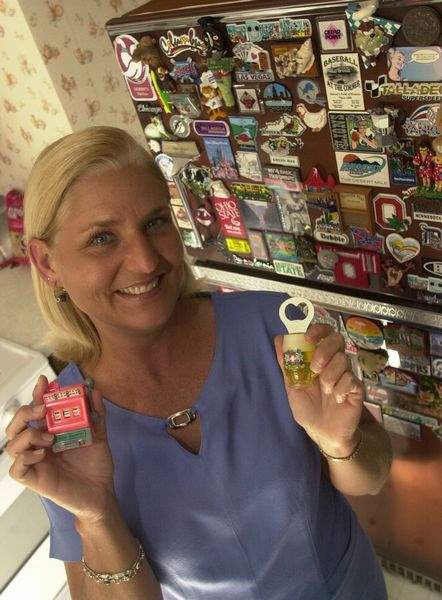
Magnetic attraction: For some the refrigerator is an art gallery
9/1/2002
Debbie Pratt began collecting refrigerator magnets in the 1980s.
blade

Debbie Pratt began collecting refrigerator magnets in the 1980s.
They hang in masses on one of the coldest spots in your home.
They hold up the Van Gogh-style artwork of your 6-year-old, cling to your grocery list, and advertise the phone number of your favorite pizza parlor. Or, they merely stand there like mini-billboards to the world.
It's an American phenomenon that can make any kitchen designer cringe in horror: The refrigerator's exterior has become the resting place for novelty magnets for many a collector.
But don't expect to see magnet fans at an auction, feverishly bidding against one another for a $3 variety that reads, “`Welcome Friends; Family by Appointment” or a 2-by-4-inch magnet in the shape of a cowboy boot.
No, these good-natured types buy refrigerator magnets for $2 to $4 at greeting card stores; while standing in line at the market, or on vacation. Sometimes they receive them from friends and family who know they love to place multiple magnets on the refrigerator door in self-arranged exhibits. There are even Web sites such as www.magnets.com and www.magnetsforyourrefrigerator.com that sell the miniature billboards online.

The most popular magnets are those with humorous phrases and parodies.
“The refrigerator is up in the corner all by itself, it needs company. My collection just kind of mushroomed,” explained Debbie Pratt, whose self-described “tacky” collection includes everything from a voodoo magnet to a library advertisement.
“It started back in the early '80s, when my mother-in-law brought me back a magnet from vacation with a goose on it,” said the commercial real estate administrative assistant at Fifth Third Bank.
Sounding like a sinner during confession, Ms. Pratt added that her next magnet was one that read “Debbie's Kitchen.” Those gifts ballooned into a collection that today boasts 151 refrigerator magnets.
“I love them for their tackiness value. They have to be tacky to hang on my refrigerator. You can't spend more than $4 on one,” said Ms. Pratt, who takes pride in knowing the story behind each of her magnets.
She owns magnets from all over the world - Japan, Paris, throughout Europe. Many that are from Germany were given to her as a gift from her daughter, Christine, 20, who is stationed there with the military.
Cultural anthropologist Thomas Maschio said collecting refrigerator magnets reveals a lot about American culture as well as the individual collector.
“When I walk into the kitchen of a family, the refrigerator jumps out at me as being marked as an object that has special meaning. Placing magnets on the refrigerator marks it off as a sacred space,” said Mr. Maschio, vice president of the consulting firm Cultural Dynamics, based in Westport, Conn. He frequently consults on cultural rituals and symbolism for the appliance industry.
Who knew there was a theory for the way magnets are placed on the fridge?
Mr. Maschio said items with emotional qualities for the bearer, such as photographs of loved ones and children's artwork, are often placed at eye-level on the refrigerator. The advertising-style magnets, that of insurance agents or pizza parlors, are placed in a more peripheral space such as the side of the refrigerator.
“Magnets themselves are indicators of personal and cultural identity. They are indicators of a person's take on life. The novelty magnets can bring a certain joy or pleasure to a person, or express their philosophy on the refrigerator,” Mr. Maschio added.
George Allee president/owner of the Web site www.magnetsforyourrefrigerator.com, said refrigerator magnets are more popular now than ever. His company, located outside Sarasota, Fla., sells some 5,000 magnets per year in the retail market.
Mr. Allee said magnet collecting began to be popular during the late 1980s, but after Sept. 11, he said he had to shut down his Web site for five months to handle the high volume of orders placed for patriotic-style refrigerator magnets.
“This craving for magnets is amazing. Some people seem to order and reorder and reorder. It's not uncommon for one person to order 20 to 30 magnets . . . I don't know where they're putting them all, they must have more than one refrigerator in the house,” said Mr. Allee, who is developing a new Web site to address the popularity of magnets among youth and college students, www.supportourschool.com. It will be a fundraising effort that will give back 30 percent of money raised from magnet orders placed on the school's behalf.
The most popular magnets, said Mr. Allee, are those with humorous phrases and parodies.
“We sell NASCAR magnets, which is basically a guy thing, so I think it's everybody and all types out there who collect magnets. People are so excited about their refrigerator magnets . . . everybody seems to have a something different that they like,” said Mr. Allee.
Jerri Banks, who was recently buying two Clay Critters magnets at the Libbey Glass Factory outlet in downtown Toledo, said her refrigerator's surface is loaded with animal magnets of all types.
“I've always been an animal lover, and during vacation one year I saw a cute little bear magnet in a gift shop and I've been hooked ever since.” Mrs. Banks added that friends know of her passion and often give her animal magnets as gifts or as a souvenir from a trip.
Clay Critters is a West Lafayette, Ind.-based company selling souvenir and gift magnets, including marine life, wildlife, zoo and farm animals.
Mr. Maschio said magnets are often a significant source of pride for the collector.
“There's a value of domesticity being exhibited, a great aspect of what the American culture is all about. They also represent a sense of domestic fun and the whimsical nature of family life, and the outlook of individual personalities,” he added.
Ms. Pratt offers simpler explanation:
“Some people collect beer cans, others baseball caps. I collect refrigerator magnets.”